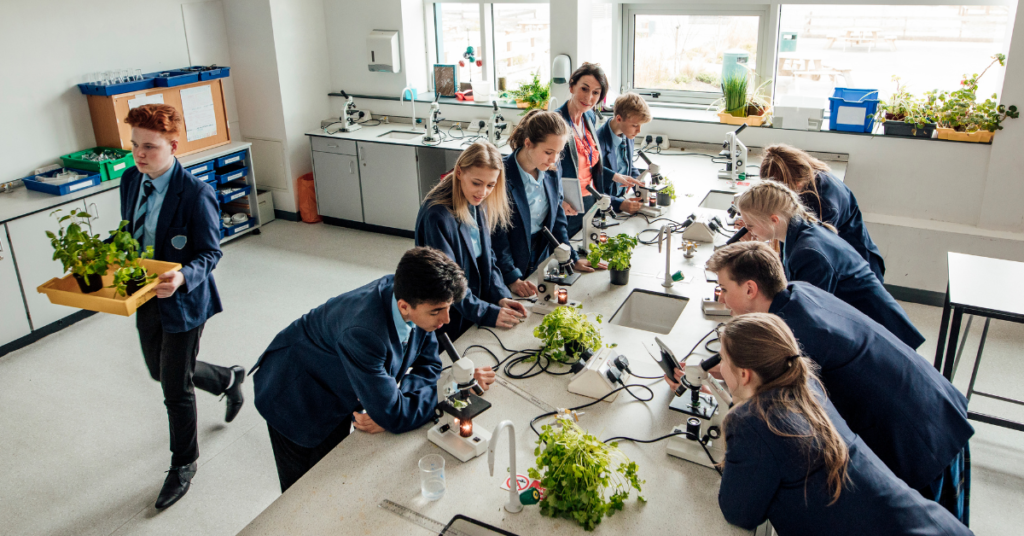Written by Cristina M. Hiddleston, assistant director, Schlegel Center for Service and Justice, Creighton University, Omaha, NE, CristinaHiddleston@creighton.edu and Jennifer Reed-Bouley, Ph.D., professor and program director of theology, College of Saint Mary, Omaha, NE, jreed-bouley@csm.edu
As educators in Catholic schools, our Catholic faith offers a foundation to heal fractures in our society. The Catholic worldview expressed in the teachings of Christ as recorded in the gospels, throughout our Catholic tradition, and in Catholic Social Teaching (CST) authored by popes and bishops can educate our students to care for creation.
One of the defining characteristics of Catholic schools is that they are “Steeped in a Catholic Worldview” (NSBECS, Defining Characteristics of Catholic Schools). The Catholic worldview includes the ways we imagine society, work, people, human life and the world God created. Part of this Catholic worldview involves care for creation as an essential pathway toward fulfilling Catholic schools’ educational mission.
Catholic Social Teaching
As the United States Conference of Catholic Bishops (USCCB) exhorts us, “We show our respect for the Creator by our stewardship for creation. Care for the earth is not just an Earth Day slogan, it is a requirement of our faith. We are called to protect people and the planet, living our faith in relationship with all of God’s creation. This environmental challenge has fundamental moral and ethical dimensions that cannot be ignored.”
Pope Francis
Similarly, Pope Francis in Laudato Si’ instructs “that our common home is like a sister with whom we share our life and a beautiful mother who opens her arms to embrace us” (para. 1). He goes on to invoke the inspiration of his namesake: “What is more, Saint Francis, faithful to Scripture, invites us to see nature as a magnificent book in which God speaks to us and grants us a glimpse of his infinite beauty and goodness” (para. 12). Pope Francis also invites us as Catholic school educators to look to the example of Jesus in our relationship to creation: “The Lord was able to invite others to be attentive to the beauty that there is in the world because he himself was in constant touch with nature, lending it an attention full of fondness and wonder” (para. 97).
Laudato Si’ summarizes the far-reaching consequences of ignoring this call to care for creation and ties stewardship for creation to familiar calls to advance the common good by walking with the excluded. “In the present condition of global society, where injustices abound and growing numbers of people are deprived of basic human rights and considered expendable, the principle of the common good immediately becomes, logically and inevitably, a summons to solidarity and a preferential option for the poorest of our brothers and sisters” (para. 158). Thus, Catholic schools are being called on to teach that care for creation involves not only appreciating the beauty of nature but also safeguarding the global goods of creation for current and future generations.
What is the role of educators in this dialogue and call to action? As Laudato Si’ suggests, “Environmental education should facilitate making the leap towards the transcendent which gives ecological ethics its deepest meaning. It needs educators capable of developing an ethics of ecology, and helping people, through effective pedagogy, to grow in solidarity, responsibility and compassionate care” (para. 210).
School Practices and Curriculum
Catholic schools have a unique opportunity to answer this call of CST and of Laudato Si’ by living out the ethics of ecology and through effective pedagogy. Catholic school leaders can often find great inspiration to educate for environmental sustainability in their school’s mission statement or particular charism. They can use the mission and charism of their school to guide their school community’s unique pursuits of care for creation.
For example, some Catholic schools partner with local organizations to produce sustainability studies for their buildings and grounds. Options for building a more sustainable physical plant include installation of solar panels, contracting with local composting groups to divert waste from landfills and/or geothermal heating and cooling systems.
Furthermore, Catholic school leaders can encourage the cultivation of care for creation across all departments through curriculum development. For example, leaders can utilize professional development opportunities to encourage faculty members to identify literature pieces, history lessons, scientific exploration and mathematical applications relevant to caring for creation (NSBECS 7.2). Students can learn to evaluate the use of technology in light of concern for the planet as a common good (NSBECS 7.5). Catholic school educators can set the example in classrooms to aid students in growing in “solidarity, responsibility and compassionate care” for creation in tangible ways such as dedicated recycling and composting throughout the school community, and through targeted sustainability lesson planning throughout the year at every grade level across disciplines (Laudato Si’, para. 210).
School Culture Possibilities
Perhaps the most exciting part of a schoolwide commitment to care for creation is the potential for a unified school culture in support of these endeavors. Students who learn to recycle/compost and students who study the impacts of the solar panels at their school or the possibilities of high-efficiency lighting, heating and cooling are likely to be incredibly proud of their school’s pursuit of care for creation. As the generation set to inherit creation, students who gain knowledge and skills at school are likely to take personal ownership in moving sustainability efforts forward and they are likely to become sustainability leaders in their own households and in their larger communities (NSBECS 7.4).
This is the first in a series of two blogs on integrating Catholic Social Teaching in school curriculum. Read the second post here: Preparing Students to Live in a Racially Diverse Society.
